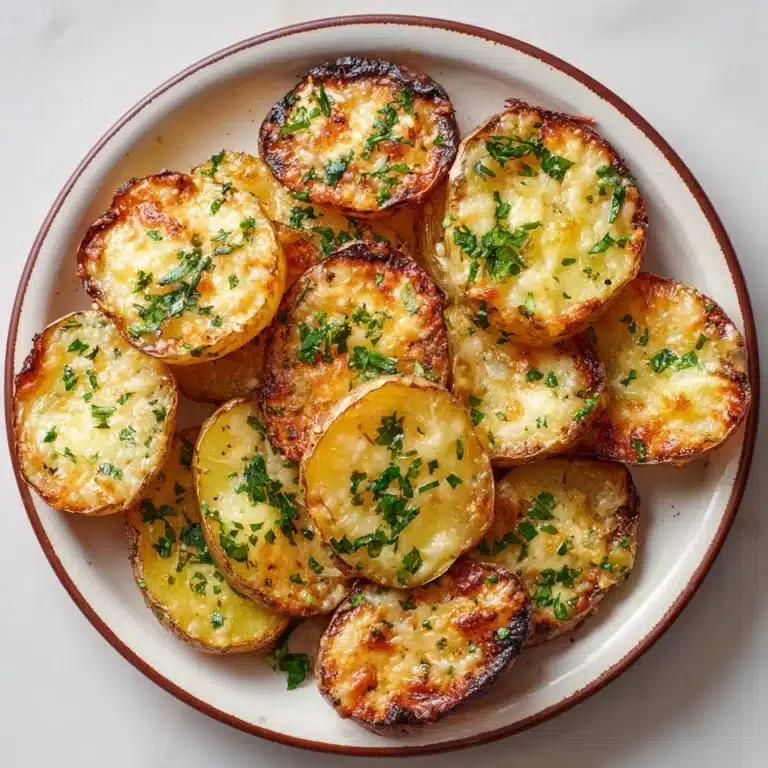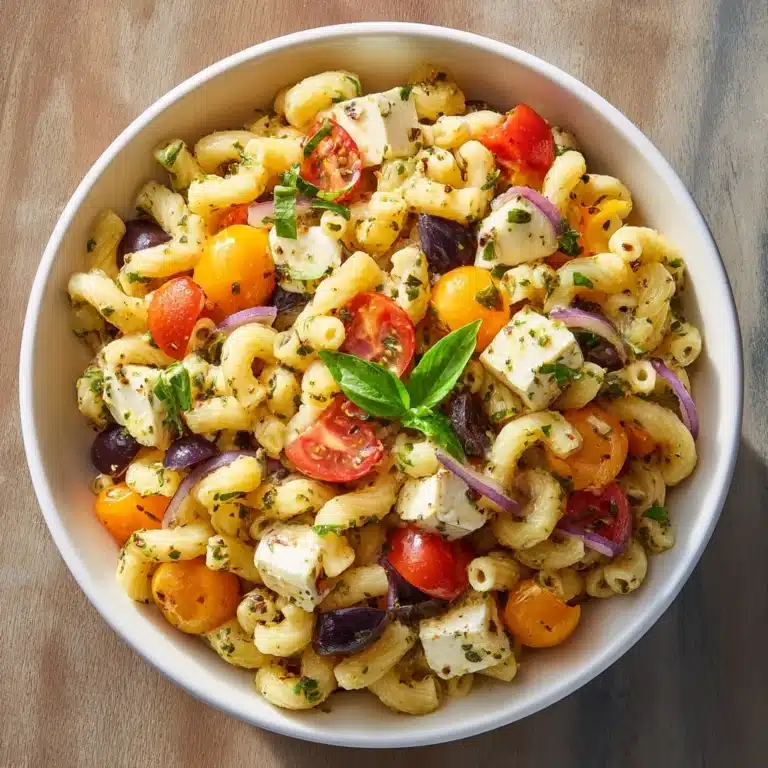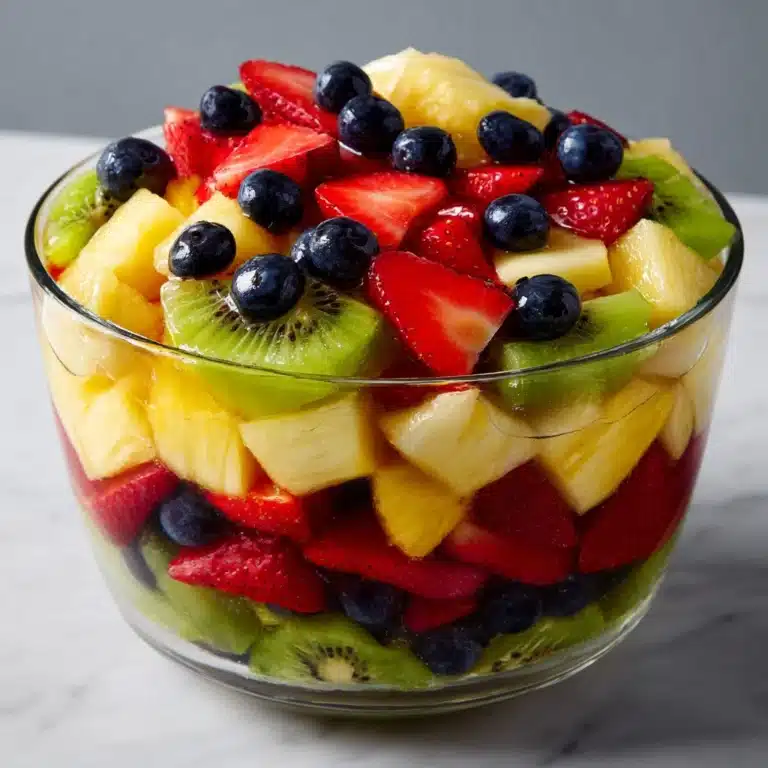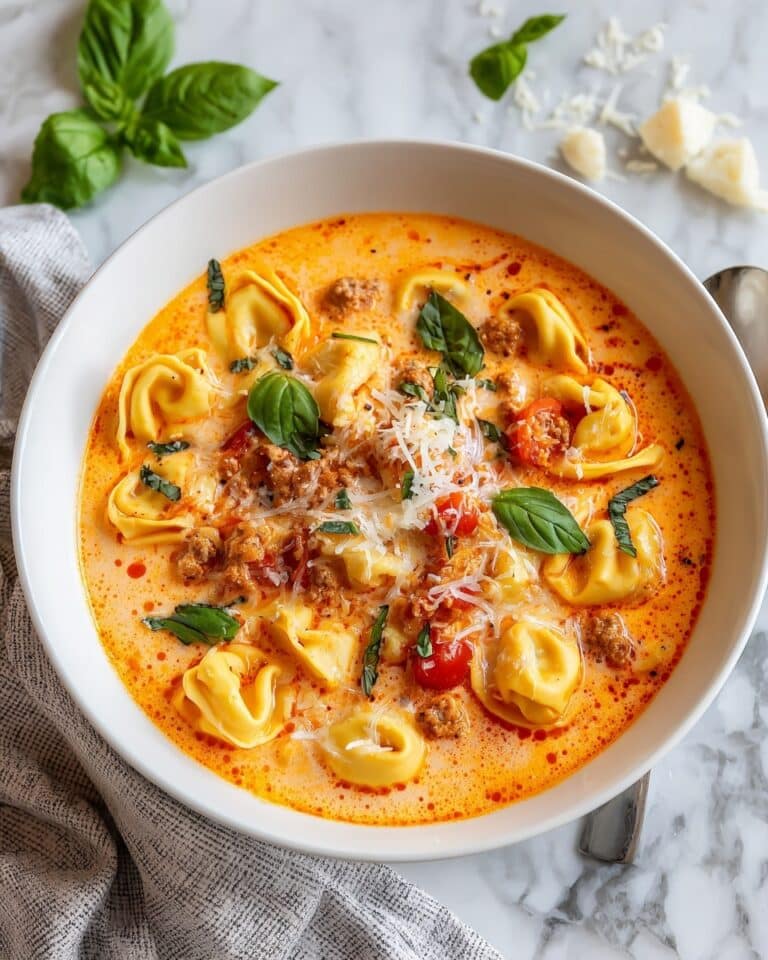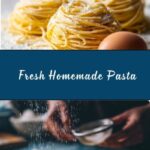Homemade Pasta from Scratch Recipe
If you have ever dreamed of capturing the magic of Italian cooking right in your own kitchen, this Homemade Pasta from Scratch Recipe will be your new go-to. It’s astonishing how just a handful of simple ingredients can transform into silky, tender pasta that tastes miles better than store-bought. From mixing the dough to cutting those perfect ribbons, making pasta from scratch is both a satisfying and delicious journey that connects you with a timeless culinary tradition. This is not just a recipe; it’s an invitation to slow down, enjoy the craft, and savor each bite of your lovingly made pasta.

Ingredients You’ll Need
The beauty of this Homemade Pasta from Scratch Recipe lies in its simplicity. Each ingredient plays a crucial role in bringing about the perfect texture and flavor—nothing fancy, just essentials that you likely already have in your pantry.
- 2 cups all-purpose flour: Provides the structure and chewiness essential for classic pasta texture.
- 3 large eggs: The binding agent that enriches the dough, making it tender and smooth.
- 1/2 tsp salt: Enhances flavor right from the dough itself.
- 1 tbsp olive oil (optional): Adds richness and helps keep the dough supple, making rolling easier.
How to Make Homemade Pasta from Scratch Recipe
Step 1: Prepare the Dough
Start by creating a mound of flour on a clean surface or in a large bowl, then make a well in its center. Crack the eggs into this well, add the salt and optional olive oil, then begin beating the eggs gently with a fork. Gradually incorporate the surrounding flour until a shaggy dough starts to come together. This technique helps evenly blend the wet and dry ingredients without making a mess.
Step 2: Knead to Perfection
Once your dough is formed into a rough ball, gather it and start kneading on a lightly floured surface. This step is crucial for developing gluten, which gives pasta its beautiful elasticity. Knead for about 8 to 10 minutes until your dough feels smooth, soft, and elastic to the touch. Don’t rush this step—your patience here is rewarded with pasta that holds sauce beautifully. After kneading, wrap the dough in plastic wrap or cover with a damp cloth and let it rest for 30 minutes at room temperature to relax.
Step 3: Roll and Shape Your Pasta
Divide your rested dough into four manageable pieces. Using a floured surface or a pasta machine, roll each piece out to your preferred thickness. Whether you’re making fettuccine, tagliatelle, or sheets for lasagna, the key is to get an even thickness to ensure uniform cooking. Cut your rolled dough into your desired shapes, letting your creativity shine as you decide what kind of pasta you want to enjoy.
Step 4: Cook to Al Dente
Bring a large pot of salted water to a rolling boil, then gently add your fresh pasta. Fresh pasta cooks much faster than dried varieties—just 2 to 4 minutes will do before it reaches the ideal al dente texture where it’s tender but still has a slight bite. Drain immediately to avoid overcooking, and get ready for the best part: serving your freshly made pasta.
How to Serve Homemade Pasta from Scratch Recipe
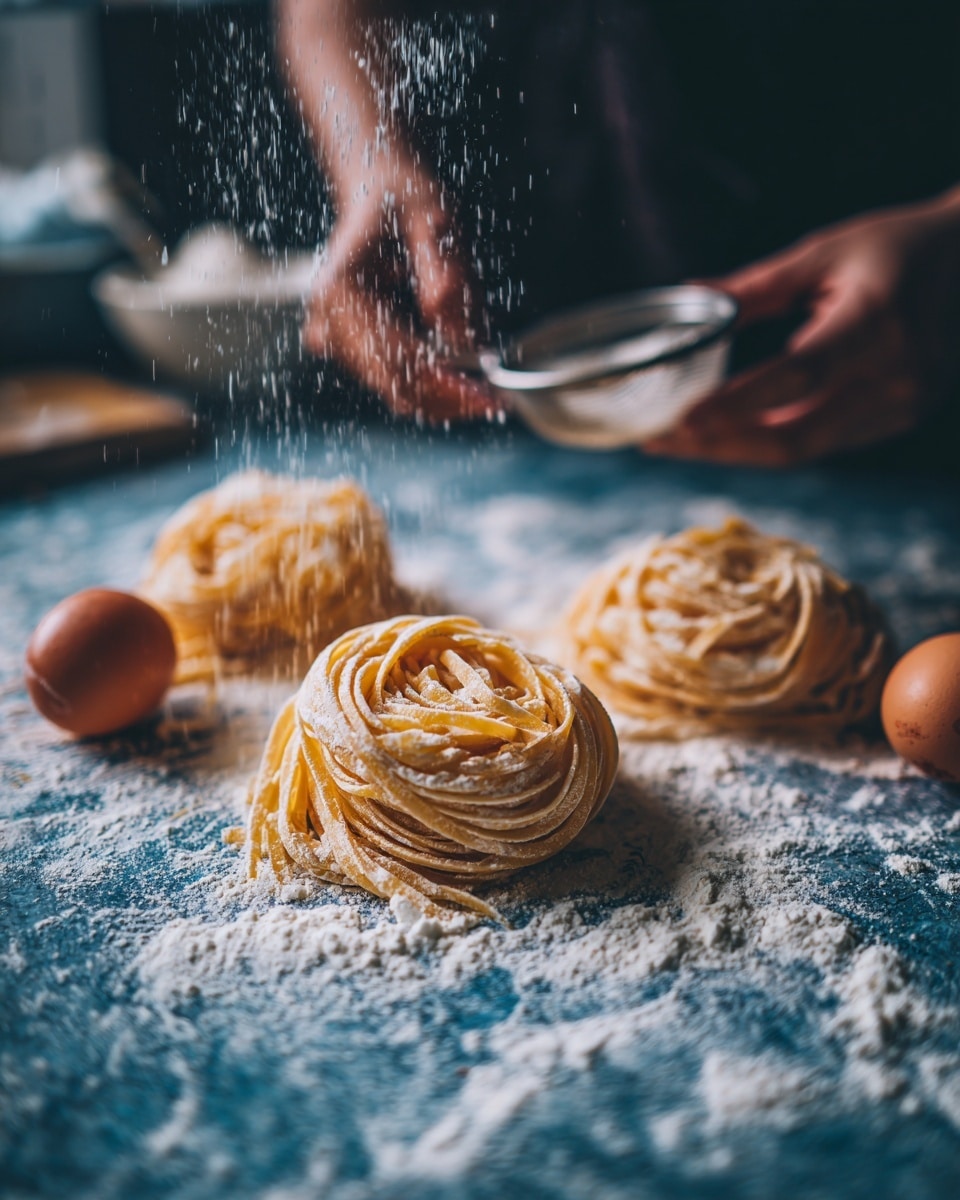
Garnishes
Adding the right garnishes can elevate your pasta into a culinary masterpiece. Fresh herbs like basil, parsley, or oregano bring vibrant color and refreshing aroma. A generous sprinkle of freshly grated Parmesan or Pecorino Romano offers a salty, nutty finish. A drizzle of extra virgin olive oil or a few flakes of red chili pepper can add a welcome touch of richness or heat, depending on your mood.
Side Dishes
Pair your homemade pasta with simple side dishes to create a balanced meal. A crisp green salad with lemon vinaigrette contrasts beautifully with the richness of the pasta. Garlic bread, toasted to golden perfection, not only complements the pasta but also lets you scoop up every last bit of sauce. Steamed or roasted seasonal vegetables can add freshness and color to your plate, enhancing the overall dining experience.
Creative Ways to Present
Serving your Homemade Pasta from Scratch Recipe with a bit of flair makes the meal feel extra special. Try twirling long pasta onto warm plates so it looks like elegant nests. For layered pasta like lasagna, slice into neat squares to showcase those beautiful, distinct layers. Use rustic wooden boards or colorful ceramic dishes to add charm and warmth to your presentation, inspiring your guests to enjoy every strand and bite.
Make Ahead and Storage
Storing Leftovers
If you find yourself with extra fresh pasta, store it properly to maintain its delicate texture. Lay the pasta flat on a baking sheet dusted with flour and cover with plastic wrap. Refrigerate for up to 24 hours—beyond that, it might start drying out or stick together. Avoid stacking fresh pasta too thickly to prevent clumps forming.
Freezing
To keep your homemade pasta longer, freezing is a fantastic option. Arrange the cut pasta in a single layer on a floured baking sheet and freeze until solid, about an hour. Then transfer it into airtight freezer bags or containers. When frozen this way, pasta can last for up to two months and cooks just as beautifully straight from the freezer with an additional minute or two in boiling water.
Reheating
Reheat your cooked fresh pasta gently to preserve its tender texture. The best method is tossing it quickly in a hot pan with sauce or a little butter until warmed through. Avoid microwaving, which tends to dry out fresh pasta. If refrigerated, add a splash of water before reheating to restore moisture.
FAQs
Can I use other types of flour for this pasta?
Absolutely! While all-purpose flour is standard and reliable, using “00” flour can yield an even silkier dough. Whole wheat flour adds nuttiness but may require a bit more liquid. Experimenting with different flours can personalize your homemade pasta experience.
Is olive oil necessary in the dough?
Olive oil is optional and often added to enrich the dough, making it more pliable and easier to roll. That said, traditional pasta doughs don’t always include it, and your pasta will still turn out fantastic without any oil.
How thick should I roll out the pasta dough?
This depends on the type of pasta you want. For ribbons like fettuccine, aim for about 1/8-inch thickness. Lasagna sheets are best slightly thicker. If using a pasta machine, settings usually range from 1 (thickest) to 7 or 8 (thinnest).
Can I add flavors or colors to the pasta dough?
Definitely! Incorporate finely chopped herbs, spinach puree, or beet juice for natural colors and extra flavor. Just substitute part of the egg or water content to keep the dough’s consistency right.
How do I prevent fresh pasta from sticking together?
Dust your cut pasta generously with flour to keep pieces separate. Also, avoid piling pasta too high before cooking. Tossing immediately into boiling water helps prevent sticking, and stirring gently during cooking is key.
Final Thoughts
There is nothing quite like the tactile joy and delicious payoff of mastering your own Homemade Pasta from Scratch Recipe. It turns cooking into a fun, rewarding experience that fills your kitchen with wonderful aromas and your table with authentic flavor. Whether you’re cooking an intimate dinner or impressing friends, this recipe brings a slice of Italy home in the most delicious way. Go on, roll up your sleeves and make pasta like you never have before—you won’t regret it!
Print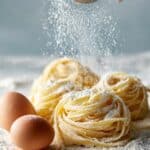
Homemade Pasta from Scratch Recipe
- Total Time: 54 minutes
- Yield: 4 servings 1x
Description
This homemade pasta recipe teaches you how to make fresh, tender pasta from scratch using simple ingredients. With a straightforward process of mixing, kneading, rolling, and cooking, you’ll create delicious pasta that cooks quickly and pairs perfectly with any sauce.
Ingredients
For the Pasta Dough
- 2 cups all-purpose flour (plus extra for dusting)
- 3 large eggs
- 1/2 tsp salt
- 1 tbsp olive oil (optional)
Instructions
- Make the Dough: On a clean surface or in a large bowl, mound the flour and create a well in the center. Crack the eggs into the well and add salt and olive oil if using. Beat the eggs with a fork, gradually incorporating the surrounding flour until a shaggy dough forms.
- Knead the Dough: Gather the dough and knead on a lightly floured surface for 8 to 10 minutes until it becomes smooth and elastic. Wrap the dough in plastic wrap or cover with a damp cloth and let it rest for 30 minutes at room temperature.
- Roll the Dough: Divide the rested dough into four portions. Roll out each portion on a floured surface or use a pasta machine to your desired thinness. Cut the rolled dough into your preferred shapes such as fettuccine, tagliatelle, or sheets for lasagna.
- Cook the Pasta: Bring a large pot of salted water to a rolling boil. Add the fresh pasta and cook for 2 to 4 minutes until al dente. Drain the pasta and serve immediately with your favorite sauce.
Notes
- Resting the dough is crucial for developing gluten and making it easier to roll out.
- Use a pasta machine for even thickness and ease of cutting.
- Fresh pasta cooks much faster than dried, so watch closely to avoid overcooking.
- You can freeze rolled or cut pasta for later use—freeze on a baking sheet before transferring to a bag.
- Adjust salt in boiling water according to taste; it should taste like sea water to properly season pasta.
- Prep Time: 15 minutes
- Cook Time: 4 minutes
- Category: Main Course
- Method: Stovetop
- Cuisine: Italian
